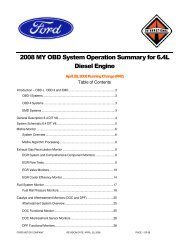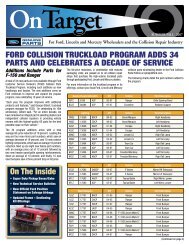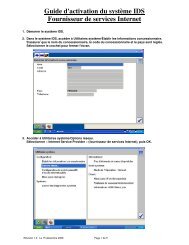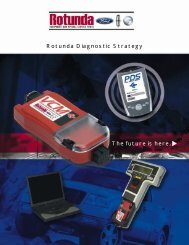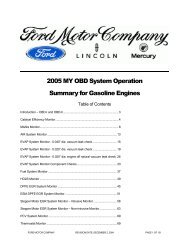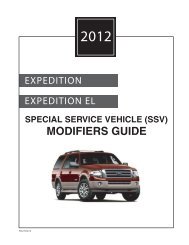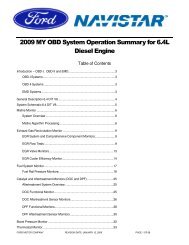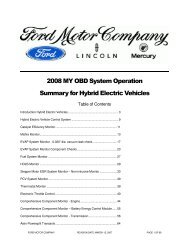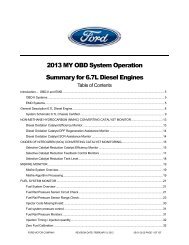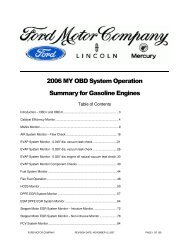2002 MY OBD-II System Operation Summary - MotorCraftService.com
2002 MY OBD-II System Operation Summary - MotorCraftService.com
2002 MY OBD-II System Operation Summary - MotorCraftService.com
You also want an ePaper? Increase the reach of your titles
YUMPU automatically turns print PDFs into web optimized ePapers that Google loves.
EVAP <strong>System</strong> Monitor - 0.040” dia. leak checkVehicles that meet enhanced evaporative requirements utilize a vacuum-based evaporative system integritycheck. The evap system integrity check uses a Fuel Tank Pressure Transducer (FTPT), a Canister Vent Solenoid(CVS) and Fuel Level Input (FLI) along with the Vapor Management Valve (VMV) to find 0.040” diameter or largerevap system leaks.The evap system integrity test is done under conditions that minimize vapor generation and fuel tank pressurechanges due to fuel slosh since these could result in false MIL illumination. The check is run after a 6 hour coldengine soak (engine-off timer), during steady highway speeds at ambient air temperatures (inferred by IAT)between 40 and 100 o F.A check for refueling events is done at engine start. A refuel flag is set in KAM if the fuel level at start-up is at least20% greater than fuel fill at engine-off. It stays set until the evap monitor <strong>com</strong>pletes Phase 0 of the test asdescribed below.The evap system integrity test is done in four phases.(Phase 0 - initial vacuum pulldown):First, the Canister Vent Solenoid is closed to seal the entire evap system, then the VMV is opened to pull a 7”H2O vacuum. If the initial vacuum could not be achieved, a large system leak is indicated (P0455). This could becaused by a fuel cap that was not installed properly, a large hole, an overfilled fuel tank, disconnected/kinkedvapor lines, a Canister Vent Solenoid that is stuck open or a VMV that is stuck closed.If the initial vacuum could not be achieved after a refueling event, a gross leak, fuel cap off (P0457) is indicatedand the recorded minimum fuel tank pressure during pulldown is stored in KAM. A “Check Fuel Cap” light mayalso be illuminated.If the initial vacuum could not be achieved and the purge vapor flow is small, a gross leak, no purge flow conditionis indicated (P1443). This could be caused by a VMV that is stuck closed, or a disconnected/blocked vapor linebetween the VMV and the FTPT.If the initial vacuum is excessive, a vacuum malfunction is indicated (P1450). This could be caused by kinkedvapor lines or a stuck open VMV. If a P0455, P0457, P1443, or P1450 code is generated, the evap test does notcontinue with subsequent phases of the small leak check, phases 1-4.Note: Not all vehicles will have the P0457 and P1443 tests or the Check Fuel Cap light implemented. Thesevehicles will continue to generate only a P0455. After the customer properly secures the fuel cap, the P0457,Check Fuel Cap and/or MIL will be cleared as soon as normal purging vacuum exceeds the P0457 vacuum levelstored in KAM.Phase 1 - Vacuum stabilizationIf the target vacuum is achieved, the VMV is closed and vacuum is allowed to stabilize.Phase 2 - Vacuum hold and decayNext, the vacuum is held for a calibrated time and the vacuum level is again recorded at the end of this timeperiod. The starting and ending vacuum levels are checked to determine if the change in vacuum exceeds thevacuum bleed up criteria. Fuel Level Input is used to adjust the vacuum bleed-up criteria for the appropriate fueltank vapor volume. Steady state conditions must be maintained throughout this bleed up portion of the test. Themonitor will abort if there is an excessive change in load, fuel tank pressure or fuel level input since these are allindicators of impending or actual fuel slosh. If the monitor aborts, it will attempt to run again (up to 20 or moretimes). If the vacuum bleed-up criteria is not exceeded, the small leak test is considered a pass. If the vacuumFORD MOTOR COMPANY REVISION DATE: OCTOBER 02, 2001 PAGE 13 OF 66



